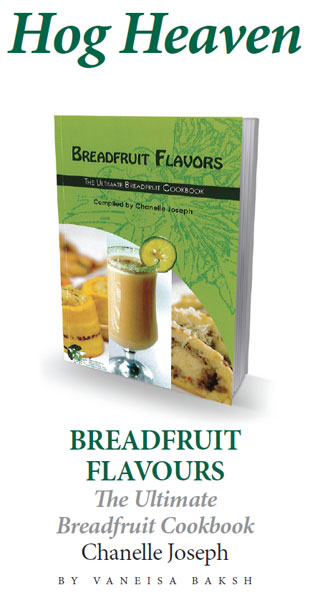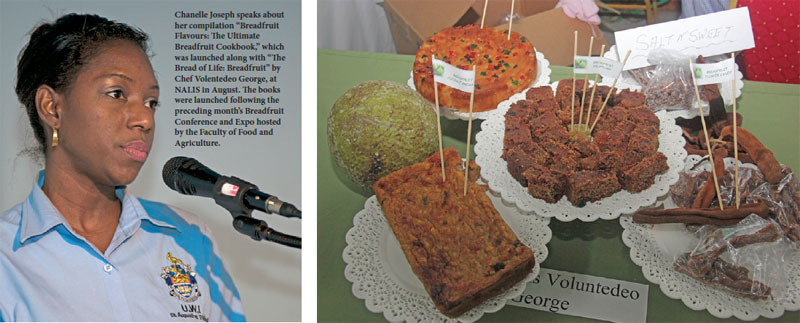|
November 2015

Issue Home >>
|


It was once hog food; too bland for the palates of the slaves brought from West Africa, and it was only after Emancipation that breadfruit found a place at the table of free peasants – and then mainly those from rural areas.
This is part of the short story told by Sandra Barnes a former librarian at The UWI in an opening chapter on “The History of Breadfruit,” in the recently published book, “Breadfruit Flavours.”
“Slow to gain acceptance and only consumed during ‘hard times’ breadfruit cookery was for many years monotonous – roasted, baked, boiled or fried, usually to accompany a main dish,” she writes, saying that times have changed since the hog food days and breadfruit has become a “staple of Caribbean cuisine and has found its way into upscale supermarkets and on to restaurant menus.”
It made me feel young; because it was news to me that the lovely, delicate flavour of the breadfruit had once lowered it to the category of hog food. I was not surprised though. Much of what had once been dismissed as poor food in the region is now prized as exotic delicacies because of the growing interest in different cuisines. Indeed, this era can be easily described as the time of the foodie – chefs, restaurants, cuisines, ingredients and techniques – these are the stars bred by food channels and devoured by people dying to excite their taste buds.
So the breadfruit, which I had only known in childhood as a rare treat cooked with spinach and coconut milk and other vegetables (not meat), was something warm, soothing and gentle, not at all bland. And it was only later, when other hands stirred the pots that I came to discover that it was as versatile as all the other provisions we still don’t take along on culinary adventures often enough.
For Chanelle Joseph, an Instructor at Agricultural Economics & Extension, at the Faculty of Food and Agriculture at The UWI St. Augustine, it brought many discoveries as well. The book covers the wide range of breadfruit uses in Caribbean kitchens, and while most recipes are built upon the basic roasted, baked, boiled or fried foundation, there are many twists that open the doors to creativity.
I asked Joseph what was her favourite dish and she said, “I enjoy cooking and was happy to try new recipes made from breadfruit. Of so many versatile and innovative recipes it is difficult to pinpoint the one I like the most. However, I had the greatest consumption of those recipes that incorporated breadfruit as a salad and as a main dish,” not surprising as her training is in Nutrition and Dietetics (and International Business), but there are many other takes.
Casseroles, salsas, fritters and chips; soups, salads, puddings and pies; you can have it stuffed and buttered and made into balls, or you can mash it and fry it and drench it in sauce. There are breads and cakes, pastas and puffs, and when you run out of things to eat there’s wine and punch.
The recipe for wontons caught me by surprise. I had imagined the breadfruit as a sort of doughy wonton skin, but no, it was the filling!
In skimming through the 115 or so recipes, I was struck by the ways the breadfruit was described for its relevance to the recipe: young, ripe, mature, green but mature, just ripe, fresh, very soft and ripe, very ripe, firm, and half-ripe. It occurred to me that my biggest problem with cooking breadfruit dishes is that I cannot distinguish between the stages of maturity, though I can tell which are firm and which are soft.
I asked Lydia, who is a breadfruit expert, how to tell the difference. “When it’s young the skin is smooth and has a greener look,” she said, and when it is full, like for oil-down, it starts getting a more yellowish hue.
I bet there are all sorts of ways to tell, and I wish readers would write in and share their techniques.
The book has devoted some attention to the nutritional value and health benefits of the breadfruit, declaring that it helps bone and heart health, and for diabetics it assists in glucose control and regulating blood glucose concentrations, among other things.
The recipes have their origins in several publications and underscore some of the subtle differences in Caribbean cuisine from island to island – it might be the addition of nutmeg here, or the amount of cheese there – little things we associate without realizing it.
Like the resurgence in cassava, coconut oil and cocoa among the list of foodie favourites, the breadfruit has made a comeback, and this book makes it easy to welcome it into your kitchen.

|





